Monthly Updates on Recent Books in the History of Christianity
To raise awareness of recent books in the history of Christianity, the editorial staff of Church History: Studies in Christianity and Culture highlights each month a list of 10-15 books in diverse periods and geographical regions that we hope will be of interest to our members. We include here below the 31st monthly list, chosen by our staff, with excerpts from the publishers’ blurbs.
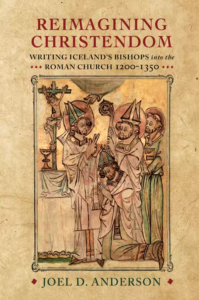
Joel D. Anderson, Reimagining Christendom: Writing Iceland’s Bishops into the Roman Church, 1200-1350. 2023
University of Pennsylvania Press
With its expanding legal system and its burgeoning throngs of lawyers, legates, and documents, the papacy of the thirteenth and fourteenth centuries has often been credited with spearheading a governmental revolution that molded the high medieval church into an increasingly disciplined, uniform, and machine-like institution. Reimagining Christendom offers a fresh appraisal of these developments from a surprising and distinctive vantage point. Tracing the web of textual ties that connected the northern fringes of Europe to the Roman see, Joel D. Anderson explores the ways in which Norse writers recruited, refashioned, and repurposed the legal principles and official documents of the Roman church for their own ends.
Drawing on little-known vernacular sagas, Reimagining Christendom is populated with tales of married bishops, fictitious and forged papal bulls, and imagined canon law proceedings. These narratives, Anderson argues, demonstrate how Norse writers adapted and reconfigured the institutional power of the church in order to legitimize some of the thoroughly abnormal practices of their native bishops. In the process, Icelandic clerics constructed their own visions of ecclesiastical order—visions that underscore the thoroughly malleable character of the Roman church’s text-based government and that articulate diverse ways of belonging to the far-flung imagined community of high medieval Christendom.

Julia Hillner, Helena Augusta: Mother of the Empire. 2022
In the middle of the third century, a girl was born on the north-eastern frontier of the Roman empire. Eighty years later, she died as Flavia Iulia Helena, Augusta of the Roman world and mother of the first Christian emperor Constantine, without ever having been married to an emperor herself. In Helena Augusta: Mother of the Empire, Julia Hillner traces Helena's story through her life's peaks, which generated beautiful imperial artwork, entertaining legends as well as literary outrage. But Helena Augusta also pays careful attention to the disruptions in Helena's life course and in her commemoration--disruptions that were created by her nearest male relatives.
Hillner shows that Helena's story was not just determined by the love of a son or the rise of Christianity. It was also--like that of many other late Roman women--defined by male violence and by the web of changing female relationships around her, to which Helena was sometimes marginal, sometimes central and sometimes ancillary. Helena Augusta offers unique insight into the roles of imperial women in Constantinian self-display and in dynastic politics from the Tetrarchy to the Theodosian Age, and it also reminds us that the late Roman female life course, even that of an empress, was fragile and non-linear.
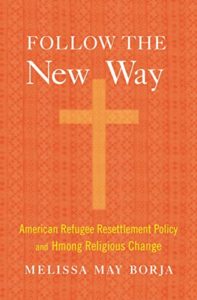
Melissa May Borja, Follow the New Way: American Refugee Resettlement Policy and Hmong Religious Change. 2023
Every year, members of the Hmong Christian Church of God in Minneapolis gather for a cherished Thanksgiving celebration. But this Thanksgiving takes place in the spring, in remembrance of the turbulent days in May 1975 when thousands of Laotians were evacuated for resettlement in the United States. For many Hmong, passage to America was also a spiritual crossing. As they found novel approaches to living, they also embraced Christianity—called kev cai tshiab, “the new way”—as a means of navigating their complex spiritual landscapes.
Melissa May Borja explores how this religious change happened and what it has meant for Hmong culture. American resettlement policies unintentionally deprived Hmong of the resources necessary for their time-honored rituals, in part because these practices, blending animism, ancestor worship, and shamanism, challenged many Christian-centric definitions of religion. At the same time, because the government delegated much of the resettlement work to Christian organizations, refugees developed close and dependent relationships with Christian groups. Ultimately the Hmong embraced Christianity on their own terms, adjusting to American spiritual life while finding opportunities to preserve their customs.
Follow the New Way illustrates America’s wavering commitments to pluralism and secularism, offering a much-needed investigation into the public work done by religious institutions with the blessing of the state. But in the creation of a Christian-inflected Hmong American animism we see the resilience of tradition—how it deepens under transformative conditions.

Matthew J. Milliner, Mother of the Lamb: The Story of a Global Icon. 2022
Mother of the Lamb tells the remarkable story of a Byzantine image that emerged from the losing side of the Crusades. Called the Virgin of the Passion in the East and Our Lady of Perpetual Help in the West, the icon has expanded beyond its Byzantine origins to become one of the most pervasive images of our time. It boasts multiple major shrines on nearly every continent and is reflected in every epoch of art history since its origin, even making an appearance at the Olympics in 2012.
Matthew Milliner first chronicles the story of the icon's creation and emergence in the immediate aftermath of the Third Crusade, whereupon the icon became a surprising emblem of defeat, its own fame expanding in inverse proportion to Christendom's political contraction. Originally born as a Christian response to the Christian violence of the Crusades, it marked the moment when Mary's ministry of suffering love truly began. Having traced the icon's origin and ubiquity, Milliner teases out the painting's theological depth, and continues the story of the icon's evolution and significance from its origins to the present day.
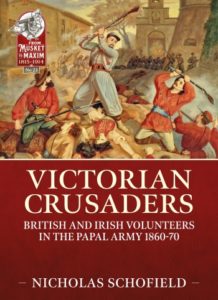
Nicholas Schofield, Victorian Crusaders: British and Irish Volunteers in the Papal Army, 1860-70. 2022
The struggle for Italian Unification brings to mind images of patriotic heroes such as Garibaldi and Mazzini. However, there is another side to the story: thousands of Catholics from across Europe (and beyond) volunteered to defend the pope from those who threatened his authority and his kingdom. These nineteenth century ‘crusaders’ included around 1,600 from England, Wales, Scotland and Ireland.
This book focuses on the turbulent period between 1860 and 1870, which saw a Piedmontese invasion of the Papal States (1860), an attempted capture of Rome by Garibaldi (1867) and finally the newly formed Italian Army’s attack of 1870, which left Rome as the kingdom’s capital. It was also a time of reform and modernization in the pontifical army, with at times inspired leadership and the introduction of new weapons and technologies.
In addition to examining the campaigns, the showpiece actions at Castelfidardo, Mentana and Porta Pia, and the political and religious context, Victorian Crusaders studies the backgrounds, motivations and experience of those who flocked to Rome from the British Isles. The Irish joined the Battalion of St Patrick in 1860 and others subsequently signed up for the Pontifical Zouaves, a glamorous transnational unit whose uniform was inspired by the warriors of the Algerian mountains. They came from varied backgrounds, including members of the aristocracy and future members of parliament, though most came from the middle classes.
Based on contemporary accounts and archives, Victorian Crusaders for the first time studies the Catholic volunteer movement between 1860 and 1870 from a British and Irish perspective.
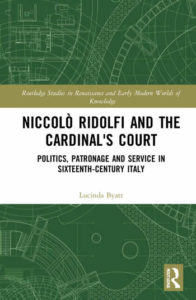
Lucinda Byatt, Niccolò Ridolfi and the Cardinal's Court: Politics, Patronage and Service in Sixteenth-Century Italy. 2022
Niccolò Ridolfi (1501–50), was a Florentine cardinal, nephew and cousin to the Medici popes Leo X and Clement VII, and he owed his status and wealth to their patronage. He remained actively engaged in Florentine politics, above all during the years of crisis that saw the Florentine state change from republic to duchy. A widely respected patron and scholar throughout his life, his sudden death during the conclave of 1549–50 led to allegations of poison that an autopsy appears to confirm.
This book examines Cardinal Ridolfi and his court in order to understand the extent to which cardinalate courts played a key part in Rome’s resurgence and acted as hubs of knowledge located on the fault lines of politics and reform in church and state, hospitable spaces that can be analysed in the context of entanglements in Florentine and Roman cultural and political patronage, and intersections between the princely court and a more professional and complex knowledge and practice of household management in the consumer and service economy of early modern Rome. Based on an array of archival sources and on three treatises whose authors were closely linked to Ridolfi’s court, this monograph explores these multidisciplinary intersections to allow the more traditional fields of church and political history to be approached from different angles.
Niccolò Ridolfi and the Cardinal's Court will appeal to all those interested in the organisation of these elite establishments and their place in sixteenth-century Roman society, the life and patronage of Niccolò Ridolfi in the context of the Florentine exiles who desired a return to republicanism, and the history of the Roman Catholic Church.
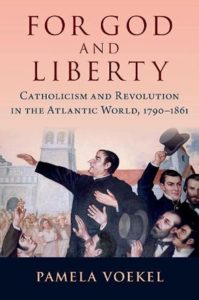
Pamela Voekel, For God and Liberty: Catholicism and Revolution in the Atlantic World, 1790-1861. 2022
The Age of Revolution has traditionally been understood as an era of secularization, giving the transition from monarchy to independent republics through democratic movements a genealogy that assumes hostility to Catholicism. By centering the story on Spanish and Latin American actors, Pamela Voekel argues that at the heart of this nineteenth-century transformation in Spanish America was a transatlantic Catholic civil war. Voekel demonstrates Reform Catholicism's significance to the thought and action of the rebel literati who led decolonization efforts in Mexico and Central America, showing how each side of this religious divide operated from within a self-conscious intercontinental network of like-minded Catholics. For its central protagonists, the era's crisis of sovereignty provided a political stage for a religious struggle. Drawing on ecclesiastical archives, pamphlets, sermons, and tracts, For God and Liberty reveals how the violent struggles of decolonization and the period before and after Independence are more legible in light of the fault lines within the Church.
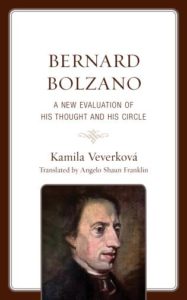
Kamila Veverková, Bernard Bolzano: A New Evaluation of His Thought and His Circle, trans. Angelo Shaun Franklin. 2022
This book introduces the ethical, philosophical, and social legacy of the work of Bernard Bolzano (1781–1848), highlighting the theological element of Bolzano’s thought. Bolzano influenced several key thinkers (primarily Catholic priests) such as Vincenc Zahradník, Josef Michael Fesl, Anton Krombholz, František Schneider, and their pupils and successors. Zahradník co-founded an important professional Czech periodical and created much of modern Czech theological terminology. Anton Krombholz became an important representative of Austrian education after 1848, working at the Vienna Ministry of Education. Based on her previous comprehensive Czech monograph, the author now highlights other new manuscripts from Krombholz’s literary legacy. She underscores connections between Bolzano's legacy and the reform movement of the Czech Catholic clergy, emphasizing that Bolzano's ideas resonated in Czech Catholic modernism in the late nineteenth and early twentieth centuries. Notwithstanding the tumultuous national development of Czechs and Germans in nineteenth-century Bohemia, Bolzano's conception of a peaceful coexistence between the two nationalities in Bohemia very favorably contributed to the preservation of the unity of the Catholic Church during such ethnically complex times. The author’s theological conception draws upon the works of Jan Milíč Lochman (1922–2004), who, in addition to writing on contemporary ecumenical themes, also dealt with the spiritual legacy of the Czech National Revival.
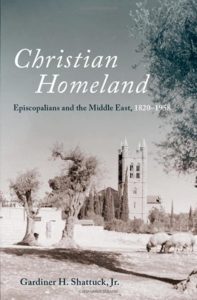
Gardiner H. Shattuck, Jr., Christian Homeland: Episcopalians and the Middle East, 1820-1958. 2022
Christian Homeland examines the history of the Episcopal Church’s involvement in missionary work in the Middle East in the nineteenth and twentieth centuries, and it describes how the denomination’s evangelistic activities and theological ideas influenced the response of church members to a variety of political and social issues affecting them as Americans during that same period. Beginning in the 1830s, Episcopalians established mission posts in Athens and Istanbul, from which they sought to convert the Muslims and Jews of the Ottoman Empire to Christianity, but failing to achieve any appreciable evangelistic success with non-Christians, they turned their attention to reforming the Eastern Christian churches instead. Receiving key assistance in these efforts from the Anglican missionary bishopric in Jerusalem, a small, but influential corps of Episcopalians dedicated themselves to keeping church members informed about the Middle East, particularly the status of the region’s Christian population, through the middle of the twentieth century. In addition to its study of Episcopal missionaries, this book explores other topics related to their evangelization concerns; these include immigration into the United States, the Armenian genocide, humanitarian relief for refugees and victims of persecution, anti-Semitism and anti-Judaism, Zionism and the formation of the State of Israel, and the contemporary Israeli-Palestinian conflict.
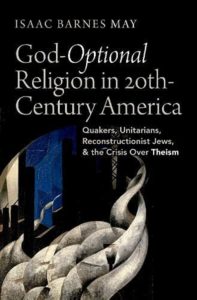
Isaac Barnes May, God-Optional Religion in Twentieth-Century America: Quakers, Unitarians, Reconstructionist Jews, and the Crisis Over Theism. 2022
By the beginning of the twentieth century, it had become harder for many Americans to believe in God. Religious groups struggled to adapt to rapidly changing cultural and scientific developments that seemed to challenge the plausibility of traditional beliefs. In God-Optional Religion in Twentieth-Century America, Isaac Barnes May focuses on the stories of three groups-liberal Quakers, Unitarians, and the forerunners of what would become Reconstructionist Judaism-that attempted to preserve their faith in the modern world by redefining what it meant to be religious. Between the 1920s and the 1960s, these communities underwent the most massive theological change imaginable, allowing their members the choice of what kind of God they wanted to believe in, or the option to not believe in God at all.
These groups pioneered the idea that being religious and believing in God might be separate concepts, a notion that spread widely, moving from church pulpits to novels and magazine covers. Eventually, the Supreme Court enshrined the idea that "God" could mean many different things in American law. God-Optional Religion in Twentieth-Century America provides an intellectual history that helps make sense of why most contemporary Americans' answer to whether they believe in God is often far more complicated than a simple "yes" or "no."
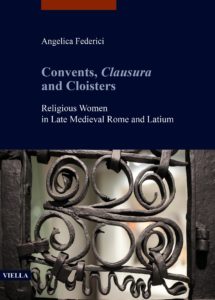
Angelica Federici, Convents, Clausura and Cloisters: Religious Women in Late Medieval Rome and Latium. 2022
Literature on late medieval nunneries in Rome and Latium is sparse. This book attempts to fill this gap, by offering an overview on conventual settlements in the region between the thirteenth and fourteenth centuries. Through the analysis of different source materials this publication presents an in depth analysis of thirteen case studies, some of which are still largely unknown. It is this combination of the well-studied and unstudied that makes this a valuable overview of the region's nunneries. By contextualising nunneries in a historical, artistic and social framework it becomes apparent that convents were culturally defining agents. Convents, Clausura and Cloisters will shed new light on this fascinating topic, and will be a resource to support further investigations.

Alan J. Clark, The Full Gospel in Zion: A History of Pentecostalism in Utah. 2023
In The Full Gospel in Zion, Alan J. Clark explores the dynamic history of Pentecostalism in Utah. Although the story of Pentecostalism now spans the globe, there is no previous study of its growth and development among the mountains and valleys of the Beehive State. This book recovers and reveals the identities of the earliest Pentecostal pioneers across the state and places the founding churches within the historical narrative of Utah religion in the twentieth and early twenty-first centuries.
Utah Pentecostals faced difficulties establishing churches and congregations in a region dominated by a Latter-day Saint majority. Pentecostals found that they shared surprising similarities in belief but faced unexpected obstacles in evangelism, as Latter-day Saints did not respond as other Christians did to the Pentecostal message. Clark draws from interviews conducted with church leaders and congregants and from the rich documentary record to show Utah Pentecostals’ perseverance in creating a strong foothold in Utah. His work offers a new look at the diversity and richness of Utah’s religious history.
Finally, for staying up-to-date on the latest titles in all fields, we recommend regularly perusing New Books Network and its "New Books in Christian Studies” page. These pages are updated regularly.
